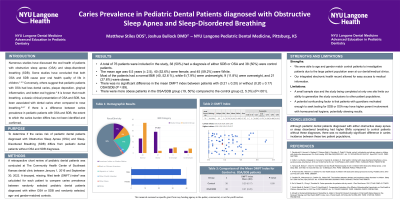Caries
170 - Caries Prevalence of Pediatric Dental Patients With Obstructive Sleep Apnea And Sleep-Disordered Breathing

- MS
Matthew Stiles, DDS
Pediatric Dental Resident, PGY2
NYU Langone Dental Medicine, Brooklyn, NY
NYU Langone Dental Medicine
Pittsburg, Kansas, United States - JB
Joshua Bullock, DMD
NYU Langone
- JB
Joshua Bullock, DMD
NYU Langone Dental Medicine
Pittsburg, Kansas, United States - DK
Daniel J. Kane, DMD
Program Director
NYU Langone Dental Medicine, Brooklyn, NY
Brooklyn, New York, United States
Presenting Author(s)
Co-Author(s)
Research Mentor(s)
Program Director(s)
Purpose: To determine if the caries risk of pediatric dental patients diagnosed with Obstructive Sleep Apnea (OSA) and Sleep-Disordered Breathing (SDB) differs from pediatric dental patients without OSA and SDB diagnoses.
Methods: Retrospective chart review of pediatric dental patients was conducted at The Community Health Center of Southeast Kansas dental clinic between January 1, 2016 and September 30, 2022. A decayed, missing, filled teeth (DMFT) index was calculated for each patient to compare caries prevalence between randomly selected pediatric dental patients diagnosed with either obstructive sleep apnea or sleep disordered breathing and randomly selected, age- and gender-matched controls.
Results: A total of 76 patients were included in the study, 38 (50%) had a diagnosis of either SDB or OSA and 38 (50%) were control patients. The mean age was 6.5 years (± 2.5), 40 (52.6%) were female, and 45 (59.2%) were White. Most of the patients had a normal BMI (40, 52.6 %), while 6 (7.9%) were underweight, 9 (11.8%) were overweight, and 21 (27.6%) were obese. There was no significant difference in the mean DMFT index between patients with (0.21 ± 0.20) or without (0.20 ± 0.17) OSA/SDB (P =.89). There were more obese patients in the OSA/SDB group (19, 50%) compared to the control group (2, 5.3%) (P < .001).
Conclusions: Although pediatric dental patients diagnosed with either obstructive sleep apnea or sleep disordered breathing had higher BMIs compared to control patients without these diagnoses, there was no statistically significant difference in caries incidence between these two patient populations.
Identify Supporting Agency and Grant Number: This research received no specific grant from any funding agency in the public, commercial, or not-for-profit sectors.

.jpg)